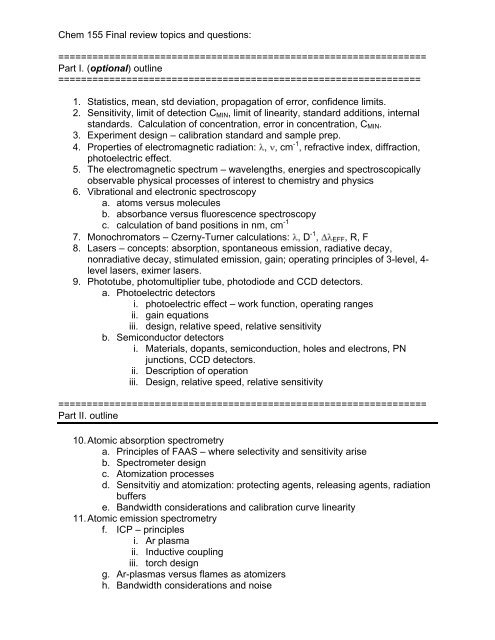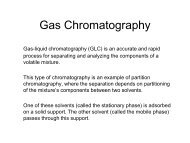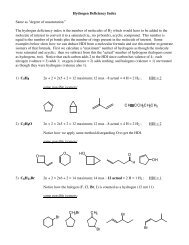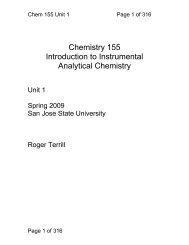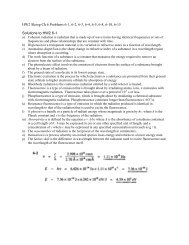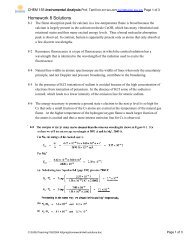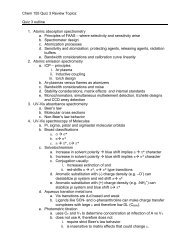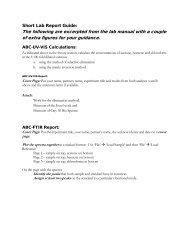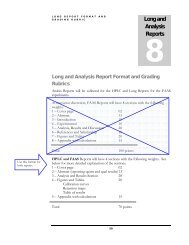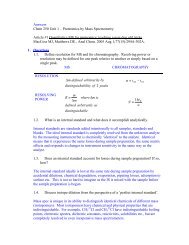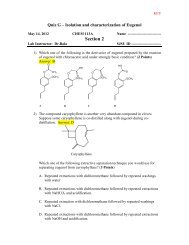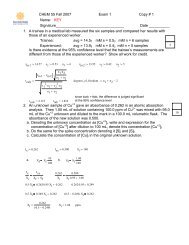Final Prep Answers
Final Prep Answers
Final Prep Answers
You also want an ePaper? Increase the reach of your titles
YUMPU automatically turns print PDFs into web optimized ePapers that Google loves.
Chem 155 <strong>Final</strong> review topics and questions:<br />
=================================================================<br />
Part I. (optional) outline<br />
================================================================<br />
1. Statistics, mean, std deviation, propagation of error, confidence limits.<br />
2. Sensitivity, limit of detection C MIN , limit of linearity, standard additions, internal<br />
standards. Calculation of concentration, error in concentration, C MIN .<br />
3. Experiment design – calibration standard and sample prep.<br />
4. Properties of electromagnetic radiation: , , cm -1 , refractive index, diffraction,<br />
photoelectric effect.<br />
5. The electromagnetic spectrum – wavelengths, energies and spectroscopically<br />
observable physical processes of interest to chemistry and physics<br />
6. Vibrational and electronic spectroscopy<br />
a. atoms versus molecules<br />
b. absorbance versus fluorescence spectroscopy<br />
c. calculation of band positions in nm, cm -1<br />
7. Monochromators – Czerny-Turner calculations: , D -1 , EFF, R, F<br />
8. Lasers – concepts: absorption, spontaneous emission, radiative decay,<br />
nonradiative decay, stimulated emission, gain; operating principles of 3-level, 4-<br />
level lasers, eximer lasers.<br />
9. Phototube, photomultiplier tube, photodiode and CCD detectors.<br />
a. Photoelectric detectors<br />
i. photoelectric effect – work function, operating ranges<br />
ii. gain equations<br />
iii. design, relative speed, relative sensitivity<br />
b. Semiconductor detectors<br />
i. Materials, dopants, semiconduction, holes and electrons, PN<br />
junctions, CCD detectors.<br />
ii. Description of operation<br />
iii. Design, relative speed, relative sensitivity<br />
=================================================================<br />
Part II. outline<br />
10. Atomic absorption spectrometry<br />
a. Principles of FAAS – where selectivity and sensitivity arise<br />
b. Spectrometer design<br />
c. Atomization processes<br />
d. Sensitvitiy and atomization: protecting agents, releasing agents, radiation<br />
buffers<br />
e. Bandwidth considerations and calibration curve linearity<br />
11. Atomic emission spectrometry<br />
f. ICP – principles<br />
i. Ar plasma<br />
ii. Inductive coupling<br />
iii. torch design<br />
g. Ar-plasmas versus flames as atomizers<br />
h. Bandwidth considerations and noise
Chem 155 <strong>Final</strong> review topics and questions:<br />
i. Stability considerations, matrix effects and internal standards<br />
j. Monochromators, simultaneous multielement detection, Echelle designs<br />
and CCD array detection<br />
12. UV-Vis absorbance spectrometry<br />
k. Beer’s law<br />
l. Molecular cross sections<br />
m. Non-Beer’s law behavior<br />
13. FTIR<br />
n. A interferometry<br />
o. IR radiation and vibrational modes<br />
p. Sampling methods: ATR, transmission mode<br />
14. Raman<br />
q. Dynamic polarizability<br />
r. Virtual States<br />
s. Stokes / Anti-stokes<br />
t. Calculations<br />
15. Mass spectrometry<br />
u. Ion source<br />
i. EI<br />
ii. ESI<br />
iii. CI<br />
iv. MALDI<br />
v. M/Z origins, isotopomers<br />
w. Analyzer types<br />
i. Resolution<br />
ii. Mass range<br />
iii. Cost<br />
iv. Pulsed / cont.<br />
x. Fragmentation patterns<br />
16. Separations<br />
y. Vocabulary<br />
z. Principles – reverse-phase and normal-phase HPLC, separation versus<br />
resolution<br />
aa. VanDeempter equation<br />
bb. Factors that determine ‘H’<br />
cc. General elution problem / solution
Chem 155 <strong>Final</strong> review topics and questions:<br />
=================================================================<br />
Part I. practice problems<br />
================================================================<br />
The following 5 measurements of light power were made:<br />
1000, 1010, 1015, 1008.<br />
Calculate the mean, standard deviation, and 95% confidence interval for this<br />
population.<br />
1000 1010 1015 1008<br />
4<br />
1008.25<br />
( 1008.25 1000) 2 ( 1008.25 1010) 2 ( 1008.25 1015) 2 ( 1008.25 1008) 2<br />
4 1<br />
6.2<br />
If concentration is related to light power by the relation: C = k*P, and k = 0.0010 +/-<br />
0.0001 and P = 9.5+/-0.2, what is the mean and standard deviation in the<br />
concentration (Error propagation)<br />
k 0.001 s k 0.0001 P 9.5 s P 0.2<br />
C k P s C C<br />
s k<br />
k<br />
2<br />
s P<br />
P<br />
2<br />
C 0.0095<br />
s C 0.0010<br />
Experimental Design<br />
A sample of soil contains about 1 to 5 grams of arsenic per 1000 Kg<br />
(metric ton).<br />
a) What approximate As conc. in ppm would result from dissolving 1.00g of soil in<br />
HF/ HNO3, filtering, and diluting to 100.0 ml<br />
2.5 g As / 1000 Kg soil * 1 Kg soil / 1000 g soil * 1.00 g soil sample = 2.5x10 -6 g As<br />
2.5*10 -6 g / 100 mL * 1000 mL / L * 10 6 g / g = 25 g / L => 25 ppb => 0.025 ppm<br />
b) Your ICP instrument can measure As in the 0.01 to 10 ppm range. What would<br />
be an appropriate range of concentrations in which to prepare standards for the<br />
above experiment<br />
1 – 200 ppb seems reasonable<br />
Low std must be > 25 ppb
Chem 155 <strong>Final</strong> review topics and questions:<br />
c) Describe how you might prepare a 0.500 ppm calibration standard from a 1000.0<br />
ppm standard solution.<br />
a. Pipet 1.00 mL and dilute to 100.0 mL 1000 ppm 10 ppm<br />
b. Pipet 1.00 mL and dilute to 20.0 mL 10 ppm * 1/20 0.500 ppm<br />
List 3 desired properties of a light detector.<br />
a. High sensitivity<br />
b. Low noise<br />
c. High quantum efficiency<br />
d. High speed<br />
2. Sketch a photomultiplier tube and label the important parts<br />
a. See notes<br />
3. How many dynodes are needed for a PMT to produce at least 1,000,000<br />
electrons per photoelectron Assume that the secondary electron yield is 4.<br />
n<br />
10 6 4 n ln ln 10 6 2.303log 10 6<br />
n<br />
( 2.3036)<br />
ln( 4)<br />
n 9.968 10 dynodes 4 10 1.049 10 6<br />
4. Is it possible to detect near infrared radiation (wavelength = 1500 nm) with a<br />
photomultiplier tube using a Na photocathode The work function of Na is 2.75<br />
eV.<br />
h 6.62610 34 J s c 3.0010 8 m s<br />
h c 1eV<br />
E<br />
150010 9 m 1.60210 19 J<br />
150010 9 m eV 1.60210 19 J<br />
E 0.827eV Since E the photoelectric effect<br />
is not promising for detection!
Chem 155 <strong>Final</strong> review topics and questions:<br />
5. By what basic mechanism does the photodiode produce an electric current when<br />
light strikes it<br />
The photodiode is reverse-biased. This means that without light, no current flows. The<br />
PN junction of the photodiode is exposed to light. When light strikes the PN junction it<br />
may create electron-hole pairs. The bias will then sweep apart the electron-hole pairs<br />
and convert the light into an electrical current.<br />
6. What happens at a p-n junction when a reverse-bias is applied Draw a diagram<br />
to support your answer. Why are photodiodes operated in reverse bias<br />
+<br />
+<br />
+<br />
+<br />
+<br />
-<br />
-<br />
-<br />
-<br />
The photon (red arrow) strikes the photodiode in the depletion region and an<br />
electron-hole pair is generated. The electron and hole (red circles) are swept<br />
apart by an electric field. In reverse bias, the diode produces zero current in the<br />
dark. Low or zero dark current is a good quality in a photo-detector.<br />
7. What is the maximum gain of a photodiode transducer Is this better than a<br />
phototube<br />
Photodiode max gain = 1 = equal to the phototube max gain.
Chem 155 <strong>Final</strong> review topics and questions:<br />
8. Draw a diagram of the photosensitive element in a charge-coupled-device array<br />
detector and illustrate what happens when light strikes this detector.<br />
- 1 0 V<br />
- 1 0 V<br />
- 1 0 V<br />
A l c o n t a c t<br />
S i O 2<br />
n - S i<br />
-<br />
-<br />
- -<br />
-<br />
-<br />
-<br />
- + - +<br />
-<br />
-<br />
- -<br />
- -<br />
-<br />
1. e- are repelled<br />
from Al contact<br />
2. h strikes<br />
depletion region<br />
3. h+ accumulate at<br />
Al contact – charge<br />
stored here is a<br />
measure of light!<br />
9. Draw a simple diagram placing the following elements in the proper order for (A)<br />
an absorbance spectrometer and (B) a fluorescence spectrometer.<br />
Detector<br />
Source<br />
Signal Processor<br />
Wavelength Selector<br />
Sample Holder<br />
A<br />
source Sample holder Wavelength sel detector Signal processor<br />
B<br />
source<br />
10. How are light power for sample and blank and sample concentration related to<br />
analyte concentration in (A) fluorescence and (B) absorbance spectrometry<br />
A fluor: P = C*k<br />
Wavelength sel detector Signal processor<br />
Sample holder<br />
The only difference is that the signal is collected<br />
at right angles to source beam!<br />
B abs: P = P0 x10-A<br />
11. Give an example of a material that is transparent in (A) the UV-Visible and Near<br />
IR, and (B) the IR regions of the EM spectrum.
Chem 155 <strong>Final</strong> review topics and questions:<br />
A silica – SiO 2 (other acceptable: sapphire, calcium fluoride)<br />
B zinc selenide – ZnSe (also germanium, silicon and potassium bromide)<br />
12. Give an example of a light source that is operative in (A) the UV-Visible and Near<br />
IR, and (B) the IR regions of the EM spectrum. For each, give an example of a<br />
line source and a continuum source.<br />
A<br />
UV, VIS or NIR line source hollow cathode lamp or laser<br />
UV, VIS or NIR continuum source tungsten halogen or Xe-arc lamp<br />
B<br />
- IR continuum source Nernst glower<br />
13. Draw a simple schematic of a laser and label the important parts.<br />
14. What processes are involved in loss and gain in a laser light cavity. Name them<br />
and give a short equation showing photons and states to indicate your answer.<br />
15. Draw an energy level diagram for a 4-level laser and indicate the levels involved<br />
in the lasing transition.<br />
16. What must be the case if laser radiation transiting the laser cavity is to be<br />
amplified by stimulated emission rather than attenuated
Chem 155 <strong>Final</strong> review topics and questions:<br />
17. Why is a 4-level laser more easily pumped than a 3-level one<br />
18. Draw an energy level diagram for an eximer laser. Indicate what molecules and<br />
what electronic states are involved in each level.<br />
19. Draw a diagram of a classical light wave and label the axes (you may ignore<br />
magnetic fields). On this wave identify the wavelength and amplitude.
Chem 155 <strong>Final</strong> review topics and questions:<br />
20. Fill in the table to indicate what happens when HeNe laser radiation (wavelength<br />
= 632.8 nm) passes from air (n = 1) into glass (n = 1.6).<br />
Wavelength / nm Frequency /<br />
Air 632.8 4.74E14 1.96<br />
Glass 395.5 4.74E14 1.96<br />
s -1<br />
Energy / eV<br />
c<br />
c<br />
3.0010 8 m s<br />
632.810 9 m<br />
4.741 10 14 Hz<br />
632.8<br />
1.6<br />
395.5<br />
E<br />
h<br />
h c<br />
6.62610 34 J s 3.0010 8 m s<br />
632.810 9 m<br />
6.2410 18 eV J<br />
1.96eV<br />
21. How much light is reflected at normal incidence<br />
2 1.6 1 1.0 2 1<br />
2 1<br />
2<br />
100% 5.3%
Energy / eV<br />
Chem 155 <strong>Final</strong> review topics and questions:<br />
22. Light of variable wavelength is incident on a piece of metal in vacuum, the metal<br />
is held at zero volts. Electrons emitted from the metal are collected and analyzed<br />
as a function of energy. Draw a diagram of the photoelectron energy versus the<br />
irradiating light frequency. Identify the x-intercept and the slope of the curve and<br />
indicate the significance of both.<br />
See notes on photoelectric effect: x-intercept is the work function of the metal –<br />
the energy required to take an electron out of the conduction band and into<br />
vacuum. The slope of the line is Plank’s constant.<br />
23. A small hypothetical molecule has the following energy level diagram. Indicate,<br />
using arrows, the transitions corresponding to infrared light absorption, visible<br />
light absorption, and visible light fluorescence. Be prepared to sketch the<br />
absorbance or fluorescence spectra as well.<br />
3<br />
2<br />
1<br />
Vis<br />
abs.<br />
Vis<br />
fluor.<br />
Vis<br />
abs.<br />
Vis<br />
fluor.<br />
0<br />
IR<br />
abs.<br />
400 500 600<br />
Wavelength / nm increasing
Path of analyte through plasma or flame <br />
Chem 155 <strong>Final</strong> review topics and questions:<br />
================================================================<br />
Part II Practice problems:<br />
================================================================<br />
1. Fill in the empty boxes consistent with the diagram. SEE NOTES<br />
In boxes 1 to 6 inddicate in what form the<br />
analyte is likely to exist:<br />
6<br />
In boxes 7 and 8 below put the<br />
equation that relates concentration<br />
and light power corresponding to<br />
emission (7) and absorption (8):<br />
5<br />
Emission<br />
7<br />
HCL<br />
h<br />
4<br />
Absorption<br />
8<br />
3<br />
2<br />
1<br />
Nebulize<br />
Liquds<br />
Solids<br />
Gases
Chem 155 <strong>Final</strong> review topics and questions:<br />
2. Compare Ar-plasma and air-C 2 H 2 flames in the following categories:<br />
Quality<br />
circle correct<br />
Electron Ar-plasma has higher lower equal air-C 2 H 2 flame.<br />
density<br />
e - density than<br />
Temperature Ar-plasma is higher lower equal air-C 2 H 2 flame.<br />
temperature than<br />
Chemical Ar-plasma has higher lower equal air-C 2 H 2 flame.<br />
reactivity<br />
reactivity than<br />
Formation of Ar-plasma is higher lower equal air-C 2 H 2 flame.<br />
oxides<br />
likelihood than<br />
Atomization<br />
efficiency<br />
Ar-plasma is superior inferior<br />
equal to<br />
air-C 2 H 2 flame.<br />
3. Compare inductively coupled plasma atomic emission spectrometry (ICP-AES) to<br />
flame atomic absorption spectroscopy (FAAS) in the following categories:<br />
Quality<br />
circle correct<br />
choice<br />
Cost to buy / ICP-AES is higher, lower, FAAS<br />
operate<br />
equal cost than<br />
Simultaneous ICP-AES is more, less, FAAS<br />
Multielement<br />
detection<br />
equally<br />
competent than<br />
Dynamic Range ICP-AES has larger, smaller, FAAS<br />
equal dynamic<br />
range than<br />
Detection Limit ICP-AES has higher, lower,<br />
equal detection<br />
limits than<br />
FAAS<br />
4. Because of the mulit-element capability and atomization / temperature sensitivity<br />
of emission intensity, the following analytical method has proved highly<br />
successful in ICP-AES:<br />
a. Standard addidions c. D2 background correction<br />
b. Internal standards d. nonlinear calibration analysis<br />
5. Formation of oxides or molecular species in flame/plasma can be suppressed by:<br />
c. EDTA or other complexing agents<br />
d. Addition of KCl to the matrix<br />
e. Addition of oxyanions such as sulfate or phosphate.<br />
f. Standard additions methods.<br />
6. Ionization of analyte atoms in flame/plasma can be suppressed by:<br />
g. EDTA or other complexing agents<br />
h. Addition of KCl to the matrix<br />
i. Addition of oxyanions such as sulfate or phosphate.<br />
j. Internal standards methods.
Chem 155 <strong>Final</strong> review topics and questions:<br />
7. Fill in the following table:<br />
Absorbance P Po %T C / M<br />
0.00 1 1.00 100 0.0000<br />
0.30 0.5 1.00 50 0.0003<br />
1.00 0.1 1.00 10 0.001<br />
2.00 0.01 1.00 1 0.002<br />
3.00 0.001 1.00 0.1 0.003<br />
A log %T<br />
100<br />
10 A %T<br />
100<br />
%T 100 10 A<br />
100 10 0.3 50 100 10 1 10 100 10 2 1 100 10 3 0.1<br />
%T 100 P P0<br />
P<br />
%T<br />
100 P0<br />
8. Based on this, comment on the relative reliability (i.e. accuracy or precision) of<br />
absorbance measurements at A=1 and A=3.<br />
A=1 is good, A=3 means light power P is 1/1000 of blank - too small of a light<br />
power signal to work with
Chem 155 <strong>Final</strong> review topics and questions:<br />
9. Define the following:<br />
a. Mobile phase<br />
b. Stationary phase<br />
c. General elution problem<br />
Changing to conditions that are strong enough to elute strongly retained<br />
components will fail to resolve weakly retained ones and conditions that are weak<br />
enough to resolve weakly retained components will fail to elute strongly retained<br />
components. Solution is GRADIENT ELUTION: to change elution conditions<br />
during chromatographic run: begin with weakly eluting conditions and ramp to<br />
strongly eluting ones. In many cases this will give adequate time to separate<br />
weakly retained species, but will elute strongly retained ones before too much<br />
broadening or time has passed
Chem 155 <strong>Final</strong> review topics and questions:<br />
10. Identify 5 processes that lead to band broadening in HPLC and describe them.<br />
Van Deemter terms can be used, plus injection zone size and column<br />
overloading.<br />
a. Eddy diffusion / multipath term<br />
b. Longitudinal diffusion<br />
c. Resistance to mass transfer<br />
d. Injection zone width<br />
e. Column overloading<br />
11. Identify the strong and weak mobile phase modifiers:<br />
Identify as strong, weak or not used.<br />
Name<br />
Stationary Water Methanol Hexane<br />
Phase<br />
Reverse-phase Oil -<br />
weak strong Not used<br />
octadecane<br />
Normal-phase Bare silica Not used strong weak<br />
12. A 1.000 cm cuvette filled with water (blank) was paced in a spectrophotometer<br />
set to 640 nm. The detector signal was 1509 A.. With a sample of 1.06x10 -5 M<br />
sample of magnesium phthalocyanine (MgPC) the detector signal read 1312 A.<br />
What is the molar extinction coefficient of MgPC<br />
A b C log<br />
P<br />
P0<br />
P<br />
log<br />
P0<br />
b C<br />
log 1312<br />
1509<br />
5.732 10 3<br />
1 1.0610 5<br />
13. Why are internal standards used in the GCMS experiment<br />
d. To compensate for injection variability.
Chem 155 <strong>Final</strong> review topics and questions:<br />
14. What is the function of the reagent blank in the metals experiment<br />
To evaluate analyte levels in the Blank.<br />
15. What is the function of the spike recovery analysis in the metals experiment<br />
To validate the sample preparation step.<br />
16. Why are the absorption and emission maxima offset for the fluorophore<br />
rhodamine 6G<br />
Absorbance is electronic plus vibrational energy change but<br />
Emission is electronic minus vibrational energy change.<br />
Abs.<br />
Em.<br />
Em. arrows<br />
are shorter.<br />
17. Why are ABC samples run without solvent to measure their FTIR specta<br />
Samples are measured “neat” because the solvent would absorb the IR radiation.<br />
18. Why is a cuvette not used to measure the FTIR spectra<br />
Typical IR chromophore has ε 100-1000 M -1 cm -1 , and neat, C may be 1-10 M.<br />
A = εC = 100 minimum.<br />
T=10 -A = 0.0000000000000000000000000000000000000000000000000000000000000000000000000000000000000000000001<br />
No light would get through…
Chem 155 <strong>Final</strong> review topics and questions:<br />
19. Circle the correct answer. In comparison to double-beam scanning<br />
spectrophotometers, diode array spectrophotometers are:<br />
Quality<br />
Spectrometer Type<br />
Diode Array Double Beam<br />
more accurate absorbance<br />
x<br />
more accurate wavelength<br />
x<br />
much faster<br />
x<br />
higher resolution<br />
x<br />
more complex<br />
x<br />
more expensive<br />
x<br />
20. What is the IR selection rule<br />
Dipole moment must change during vibration.<br />
21. What is the Raman selection rule<br />
Polarizability must change during vibration.<br />
22. Sketch the normal modes of vibration of the water molecule and indicate the<br />
Raman and IR activity:<br />
Mode Sketch IR Active Raman Active<br />
Symmetric stretch<br />
O<br />
Yes Yes<br />
H<br />
O<br />
Antisymmetric<br />
Yes<br />
No<br />
Stretch<br />
H H<br />
O<br />
Bend Yes Yes<br />
H<br />
H<br />
H<br />
23. The frequency of the Raman Stokes line for 488.0 nm laser light scattering from<br />
a 1500 cm -1 CO stretching vibrational mode.<br />
v Laser<br />
10 7 nm<br />
cm<br />
488.0nm<br />
v Laser 20492cm 1 v Vibration 1500cm 1<br />
v Raman v Laser v Vibration v Raman 18992cm 1 Stokes Line<br />
v Raman v Laser v Vibration v Raman 21992cm 1 Anti-Stokes Line
Chem 155 <strong>Final</strong> review topics and questions:<br />
24. Elaborate the following acronyms:<br />
e. ATR – Attenuated Total Reflection<br />
f. FTIR – Fourier Transform Infrared<br />
25. Which will be observed at a higher frequency the OH stretch in ethanol or the<br />
OD stretch in deuterated ethanol<br />
k<br />
OH Because H is lighter than D and v where k = bond force constant and µ<br />
= reduced mass of oscillator.<br />
26. In an FTIR, high resolution corresponds to:<br />
g. Long interferometer drive<br />
h. High beam intensity<br />
i. High absorbance<br />
j. High mirror velocity<br />
k. Double-beam optics<br />
27. Fill in the following to indicate the transitions involved in Stokes and anti-Stokes<br />
Raman scattering:<br />
S1<br />
So
Chem 155 <strong>Final</strong> review topics and questions:<br />
28. Fill in the following table:<br />
Mass analyzer Resolution<br />
(high or low)<br />
Input:<br />
Continuous / pulsed<br />
Cost<br />
(high or low)<br />
Quadrupole Low Continuous Low<br />
Double-focusing<br />
High Pulsed High<br />
electric / magnetic<br />
sector.<br />
Time of flight. High Pulsed High<br />
29. Fill in the following table:<br />
Ionization Source Fragmentation<br />
(high or low)<br />
Electron Impact<br />
High<br />
(EI)<br />
Mode:<br />
Continuous / pulsed<br />
Cont.<br />
Chemical ionization<br />
(CI)<br />
Matrix Assisted<br />
Laser Desoprtion<br />
Ionization (MALDI)<br />
Electrospray<br />
Ionization (ESI)<br />
Low<br />
Low<br />
Low<br />
Cont.<br />
Pulsed<br />
Cont.
Signal<br />
Chem 155 <strong>Final</strong> review topics and questions:<br />
30. Label the arrows:<br />
Factors that determine performance in chromatography:<br />
a<br />
b<br />
c<br />
d<br />
0 5 10 15 20 25 30<br />
Ret ention T ime / s<br />
Improve resolution a Retention Time c Band width d<br />
Improve efficiency a Determined by K P –<br />
partition coefficient<br />
Improve selectivity b Achieved by change of<br />
mobile phase<br />
Achieved by change of<br />
stationary phase<br />
c<br />
b<br />
b<br />
Set by MP velocity and<br />
SP quality<br />
Set by longitudinal<br />
diffusion<br />
Set by resistance to<br />
mass transfer<br />
Set by variable flow path<br />
d<br />
d<br />
d<br />
d


